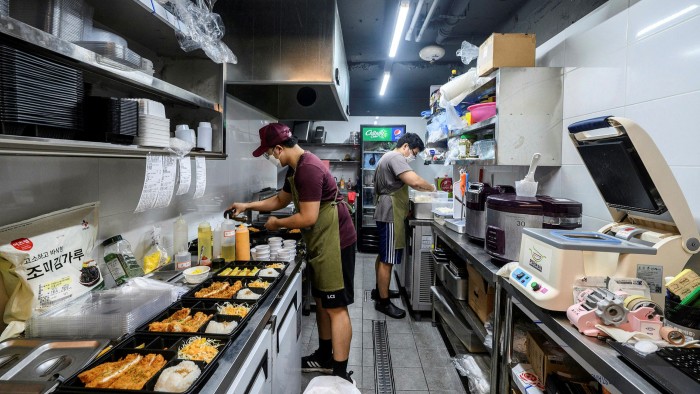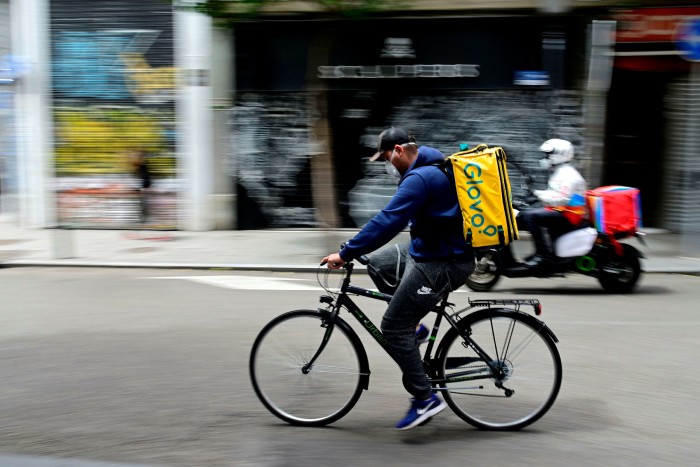Will dark kitchens make takeaways more sustainable?

Roula Khalaf, Editor of the FT, selects her favourite stories in this weekly newsletter.
Coronavirus lockdowns were hard on many businesses. But takeaway food delivery services were not among them: they prospered as consumers discovered an appetite for convenience. A survey last year by data provider Statista, for example, pointed to an average 17 per cent rise in the number of delivery service users across eight European countries.
Convenience, however, has a big carbon footprint. One 2020 Chinese study estimates that the average urban express food delivery order generates 111.8g of CO2-equivalent — about the same as driving a kilometre in a car. And, given the rising demand, that readily scales to millions of tonnes a year, globally.
But the sector’s rapid growth has also driven a boom in Europe’s “dark kitchens”, where takeaway meals are prepared solely for sale on delivery apps. The resulting economies of scale could, in principle, make the industry greener. However, working out whether that is in fact the case is far from straightforward.
Sometimes known as “cloud kitchens” or “ghost kitchens”, dark kitchens can be either facilities where a single restaurant brand prepares meals, or buildings where a number of companies share space — these tend to be in warehouses on the outskirts of cities.
It is hard to tell exactly how many dark kitchens there are. Delivery service Deliveroo runs 300 globally, each housing several different restaurant brands. In comparison, there are more than 50,000 conventional restaurants on its app in the UK alone, so dark kitchens still represent only a fraction of its business.
A number of other companies and start-ups are also working in the sector. They include Spain’s Glovo and Sweden’s Curb, as well as Foodstars in the UK.

“Dark kitchens now have a decent sized role in the urban food landscape,” says Eleonora Morganti, a researcher on food consumption and distribution at the University of Leeds in the UK.
How sustainable dark kitchens are hinges on four factors: the delivery model, the packaging, the sharing of kitchen space, and the use of data to predict customer orders — a significant efficiency advantage over dine-in eating.
Of these, the pros and cons of delivery are perhaps hardest to disentangle — and operators seem in no hurry to try. “The sustainability of delivery models is not a hot topic right now,” Morganti says.
The larger dark kitchens, which amalgamate many brands, tend to be on the edges of cities, where property is cheaper. That means delivery journeys are longer than for city-centre restaurants, which increases emissions.
Yet the more kitchens that share a location, the greater the chances of a rider consolidating several orders to the same area, which would reduce the delivery miles per meal compared with delivering from several individual takeaway sites.
“The impact is also linked to the personal mobility of each individual customer,” Morganti says. If the delivery journey replaces a customer’s 10-mile car drive to a restaurant, say, that is different from replacing a walk, cycle ride or bus trip. In practice, however, dark kitchens are next to cities, where shorter, lower-emission journeys are the norm.
The choice of delivery vehicle also matters. Deliveroo has a policy of allowing only bicycles and electric scooters to pick up from some sites, and also provides electric vehicle charging points at some locations. Yet, while this goes with the grain of regulation in many cities — London’s Ultra Low Emission Zone, for example, was expanded significantly this year — many riders still rely on petrol power.
Packaging is more straightforwardly problematic. The same Chinese study that calculated the grammage of CO2-equivalent per delivery concluded that 86 per cent of it was due to packaging. Many companies still use plastic but even recyclable cardboard or paper adds waste in comparison with restaurants.
There are solutions, though, says Anton Soulier, who runs Taster — a London-based company that licenses digital food brands to existing kitchens, as well as running dark kitchens in France, the UK and Spain.
One possibility is reusable packaging, where delivery riders collect utensils and crockery after customers use them. Soulier says the logistics are under discussion within the industry.
Other aspects of dark kitchens have clear sustainability advantages over conventional delivery services. In some of the larger premises, brands share energy-intensive equipment, such as freezers, which saves electricity. Sharing the same space also offers companies the chance to combine their supply chains and reduce the number of truck journeys needed to replenish the kitchens.
“It would be better if [supplies] were centralised,” says Morganti. “I would suggest they share ingredients or napkins. But we are in a free market, and it’s about branding and being unique — people wouldn’t want to all have the same napkins.”
But perhaps the most substantial upside arises from the amount of data that dark kitchens collect. Companies can run algorithms based on what people order and when, allowing them to predict demand and to meet it precisely.
Carl Tengberg from Swedish company Curb, which runs dark kitchens in Sweden and Denmark and creates brands for the different cuisines that use them, sees this as a decisive advantage. “With more efficient and smart kitchens, we have an edge in eliminating food waste,” he says. “Our aim is simple: zero food waste.”
Soulier says the whole industry will follow, with traditional restaurants soon bringing in data analysis software, too.
But, if dark kitchens lose their edge over dine-in restaurants in terms of data, can they ever hope to rival the sustainability credentials of the traditional restaurant?
In the end, Morganti says, it rests on combining both the supply chains of brands that share the same kitchen, and the delivery of meals to customers in the same area. If that can happen, and the industry can switch to zero-emission vehicles and reusable packaging, its eco-credentials could start to improve.
This article has been amended since first publication to clarify Taster’s location and business model

Comments